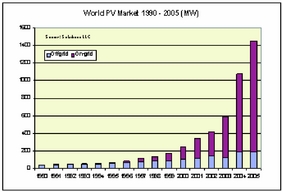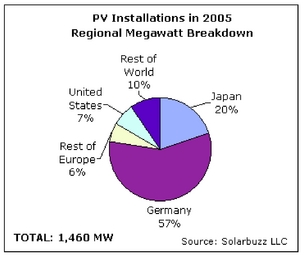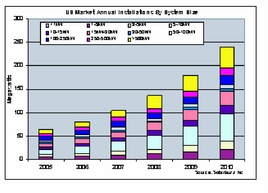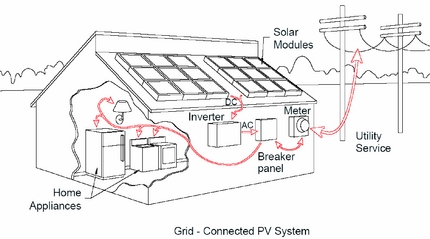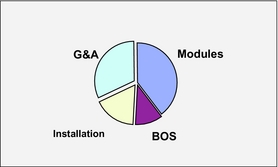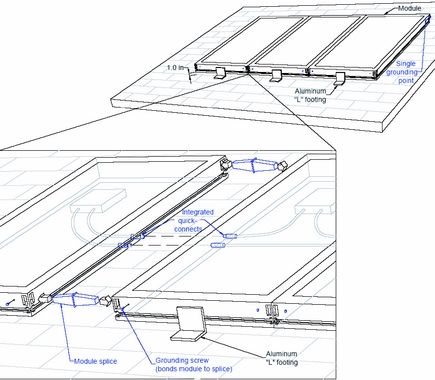The following Summary Compensation Table sets forth, for the years indicated, all cash compensation paid, distributed or accrued for services, including salary and bonus amounts, rendered in all capacities by the Company’s chief executive officer and all other executive officers who received or are entitled to receive remuneration in excess of $100,000 during the stated periods.
There were no options granted to any of the named executive officers during the year ended December 31, 2005.
During the year ended December 31, 2005, none of the named executive officers exercised any stock options.
We currently do not have employment agreements with any of our employees.
Prior to the Merger, Akeena adopted the Akeena Solar, Inc. 2006 Stock Incentive Plan. The plan allows for the grant of up to 450,000 shares of Akeena’s common stock as restricted stock or options to Akeena’s employees, directors and consultants. The Company assumed Akeena’s obligations under the plan in the Merger, as a result of which each share of Akeena restricted stock and each option granted under the plan was converted into a share of the Company’s restricted stock or an option to purchase a share of the Company’s common stock, respectively.
We currently do not have insurance insuring directors and officers against liability; however, we are in the process of acquiring such insurance.
On March 30, 2001, Akeena, Inc. purchased certain infrastructure and harvester technology (the ‘‘AWI Technology’’) from Andalay, Inc., a Delaware corporation, in exchange for warrants to purchase an aggregate of 1,000,000 shares of Akeena, Inc.’s common stock at an exercise price of $0.01 per share. Following the closing of that transaction, Andalay, Inc. changed its name to ‘‘Akeena Wireless, Inc.’’ (‘‘AWI’’). Barry Cinnamon is a director and principal stockholder and the Chief Executive Officer of AWI.
On June 2, 2006, Akeena assumed the obligations of Akeena, Inc. under the warrants in the re-domicile transaction, so that each warrant was converted into a warrant to purchase one share of
Table of Contentscommon stock of Akeena. On July 18, 2006, AWI sold the warrants for an aggregate purchase price of $30,000, which was determined by an independent, third party appraiser to be the fair market value of the warrants. 750,000 of the warrants were purchased by The Cinnamon 2006 Irrevocable Children’s Trust, a trust established for the benefit of Barry Cinnamon’s children, and 90,000 of the warrants were purchased by Barry Cinnamon. On August 11, 2006, the Company assumed the obligations of Akeena under the warrants in the Merger, so that each warrant was converted into a warrant to purchase one share of the Company’s common stock. The warrants contain anti-dilution protection and are exercisable through the earlier to occur of (i) March 30, 2011, and (ii) the closing of a Change of Control (as defined in the warrants) of the Company.
On August 8, 2006, AWI repurchased the AWI Technology from Akeena for a purchase price of $24,215.21.
On July 18, 2006, Andalay Solar, Inc. a California corporation which is wholly-owned by Barry Cinnamon, assigned all of its right, title and interest in and to Patent Application No. 10/849.069 to Akeena. The Patent Application covers our solar module technology and had previously been assigned to Andalay Solar, Inc. by Barry Cinnamon, who is the inventor of the technology.
Bruce Velestuk, President of Fairview-DE prior to the Merger, provided a cash advance of $81 to Fairview-NV during the period ended October 31, 2005. This amount is unsecured, non-in-trust bearing and has no specific terms of repayment. Mr. Velestuk also provided office premises to Fairview-NV prior to the Merger. The premises were valued by management at $450 per month. During the period from July 29, 2005 to June 30, 2006, donated rent expense of $4,950 was charged to Fairview-DE’s operations.
Item 3.02. Unregistered Sales of Equity Securities
In connection with the Merger, as of August 11, 2006, Fairview-DE accepted subscriptions for a total of 101.1 units, each unit consisting of 25,000 shares of our common stock, at a purchase price of $25,000 per unit, from accredited investors pursuant to the terms of a Confidential Private Offering Memorandum, dated July 7, 2006, as supplemented, in the Private Placement. We received gross proceeds from the closing of the Private Placement of $2,527,500.
The Private Placement was made solely to ‘‘accredited investors,’’ as that term is defined in Regulation D under the Securities Act. The units and the common stock were not registered under the Securities Act, or the securities laws of any state, and were offered and sold in reliance on the exemption from registration afforded by Section 4(2) and Regulation D (Rule 506) under the Securities Act and corresponding provisions of state securities laws, which exempt transactions by an issuer not involving any public offering.
We intend to use approximately $500,000 of the net proceeds from the Private Placement to repay an outstanding $500,000 line of credit owed to Citibank (West) FSB. We intend to use the remainder of such proceeds to continue research and development on our solar module technology and for general corporate purposes, including acquisitions, product inventory purchases, marketing, office expansion and working capital.
Because we have closed on only $2,527,500 in the Private Placement, we may need to seek additional sources of financing, including debt and equity financing, within the next 18 months, depending on our expected cash needs and the availability of cash flow at that time. Any additional equity financing would result in dilution to the percentage ownership of our existing stockholders.
We agreed to pay a placement agent the following fee in connection with the Private Placement: (1) a cash fee of 6% of the gross proceeds from sales of the units by the placement agent in the Private Placement; and (2) warrants to purchase a number of shares of common stock equal to 6% of the shares sold by the placement agent in the Private Placement at an exercise price of $1.00 per share, which expire the third anniversary of the date on which the warrants are issued.
The placement agent sold 33 units for a total of $825,000. In connection with such sales, we paid the placement agent a cash fee of $49,500 and warrants to purchase up to 49,500 shares of common stock.
44
Table of ContentsDESCRIPTION OF SECURITIES
The Company is authorized to issue 50,000,000 shares of common stock and 1,000,000 shares of preferred stock. Immediately following the Merger and the closing of the Private Placement for $2,527,500, there were 14,381,680 shares of common stock issued and outstanding and no shares of preferred stock issued and outstanding.
Common Stock
The holders of common stock are entitled to one vote per share. The Company’s Certificate of Incorporation does not provide for cumulative voting. The holders of common stock are entitled to receive ratably such dividends, if any, as may be declared by the board of directors out of legally available funds. However, the current policy of the board of directors is to retain earnings, if any, for operations and growth. Upon liquidation, dissolution or winding-up, the holders of common stock are entitled to share ratably in all assets that are legally available for distribution. The holders of common stock have no preemptive, subscription, redemption or conversion rights. The rights, preferences and privileges of holders of common stock are subject to, and may be adversely affected by, the rights of the holders of any series of preferred stock, which may be designated solely by action of the board of directors and issued in the future.
Preferred Stock
The board of directors is authorized, subject to any limitations prescribed by law, without further vote or action by the stockholders, to issue from time to time shares of preferred stock in one or more series. Each such series of preferred stock shall have such number of shares, designations, preferences, voting powers, qualifications, and special or relative rights or privileges as shall be determined by the board of directors, which may include, among others, dividend rights, voting rights, liquidation preferences, conversion rights and preemptive rights.
Warrants
The Company has outstanding warrants to purchase an aggregate of 1,000,000 shares of common stock at an exercise price of $0.01 per share. The warrants expire on the earlier to occur of (i) a Change of Control (as defined in the warrants) of the Company, and (ii) March 30, 2011.
Registration Rights
The Company has agreed to file a ‘‘resale’’ registration statement with the SEC covering all shares of common stock sold in the Private Placement on or before the date that is 90 days after the date of the closing of the Private Placement. The Company will use its reasonable best efforts to maintain the effectiveness of the ‘‘resale’’ registration statement from the effective date through and until 18 months after the closing date of the Private Placement, unless all securities registered under the registration statement have been sold or are otherwise able to be sold pursuant to Rule 144, at which time exempt sales may be permitted for purchasers of the units. The Company has agreed to use its reasonable best efforts to have such ‘‘resale’’ registration statement declared effective by the SEC as soon as possible and, in any event, within 120 days after the initial filing date.
The Company is obligated to pay to each purchaser of units a fee of 1% per month of the purchaser’s investment, payable in cash or common stock at Fair Market Value (as defined in the Registration Rights Agreement), in the discretion of the Company, up to a maximum of 6%, for each month (i) in excess of 60 days that the registration statement has not been filed, (ii) in excess of 21 days that the Company fails to respond to the initial comments of the SEC, and (iii) in which the Company fails to use its reasonable best efforts to cause the registration statement to be declared effective.
The description of registration rights is qualified in its entirety by reference to the Registration Rights Agreement filed herewith as Exhibit 10.3.
Lock-up Agreements
All shares of common stock held by officers and directors of the Company (together with the shares held by their respective affiliates) (the ‘‘Lock Up Shares’’) are subject to lock-up provisions
45
Table of Contentsthat provide restrictions on the future sale of common stock by the holders and their transferees. These lock-up provisions provide, in general, that the Lock Up Shares may not, directly or indirectly, be offered, sold, offered for sale, contracted for sale, hedged or otherwise transferred or disposed of for a period of twelve (12) months following the closing of the Private Placement.
Market Price and Dividends
Akeena is, and has always been, a privately held company and now is a wholly-owned subsidiary of the Company. There is not, and never has been, a public market for the securities of Akeena. Akeena has never declared or paid any cash dividends on its capital stock. In addition, Fairview-NV’s common stock has been approved for quotation on the OTC Bulletin Board, but there has never been a trading market for the stock.
Indemnification of Directors and Officers
Section 145 of the Delaware General Corporation Law (‘‘DGCL’’) provides, in general, that a corporation incorporated under the laws of the State of Delaware, such as the Company, may indemnify any person who was or is a party or is threatened to be made a party to any threatened, pending or completed action, suit or proceeding (other than a derivative action by or in the right of the corporation) by reason of the fact that such person is or was a director, officer, employee or agent of the corporation, or is or was serving at the request of the corporation as a director, officer, employee or agent of another enterprise, against expenses (including attorneys’ fees), judgments, fines and amounts paid in settlement actually and reasonably incurred by such person in connection with such action, suit or proceeding if such person acted in good faith and in a manner such person reasonably believed to be in or not opposed to the best interests of the corporation, and, with respect to any criminal action or proceeding, had no reasonable cause to believe such person’s conduct was unlawful. In the case of a derivative action, a Delaware corporation may indemnify any such person against expenses (including attorneys’ fees) actually and reasonably incurred by such person in connection with the defense or settlement of such action or suit if such person acted in good faith and in a manner such person reasonably believed to be in or not opposed to the best interests of the corporation, except that no indemnification will be made in respect of any claim, issue or matter as to which such person will have been adjudged to be liable to the corporation unless and only to the extent that the Court of Chancery of the State of Delaware or any other court in which such action was brought determines such person is fairly and reasonably entitled to indemnity for such expenses.
The Company’s Certificate of Incorporation and Bylaws provide that the Company will indemnify the Company’s directors, officers, employees and agents to the extent and in the manner permitted by the provisions of the DGCL, as amended from time to time, subject to any permissible expansion or limitation of such indemnification, as may be set forth in any stockholders’ or directors’ resolution or by contract. In addition, the Company’s director and officer indemnification agreements with each of its executive officers and directors provide, among other things, for the indemnification to the fullest extent permitted or required by Delaware law, provided that such indemnitee shall not be entitled to indemnification in connection with any ‘‘claim’’ (as such term is defined in the agreement) initiated by the indemnitee against the Company or the Company’s directors or officers unless the Company joins or consents to the initiation of such claim, or the purchase and sale of securities by the indemnitee in violation of Section 16(b) of the Exchange Act.
Any repeal or modification of these provisions approved by the Company’s stockholders shall be prospective only, and shall not adversely affect any limitation on the liability of a director or officer of the Company existing as of the time of such repeal or modification.
The Company is also permitted to apply for insurance on behalf of any director, officer, employee or other agent for liability arising out of his actions, whether or not the DGCL would permit indemnification.
Anti-Takeover Effect of Delaware Law, Certain By-Law Provisions
Certain provisions of the Company’s By-Laws are intended to strengthen the board of directors’ position in the event of a hostile takeover attempt. These provisions have the following effects:
46
Table of Contents |  |  |
| • | they provide that only business brought before an annual meeting by the board of directors or by a stockholder who complies with the procedures set forth in the By-Laws may be transacted at an annual meeting of stockholders; and |
 |  |  |
| • | they provide for advance notice or certain stockholder actions, such as the nomination of directors and stockholder proposals. |
The Company is subject to the provisions of Section 203 of the DGCL, an anti-takeover law. In general, Section 203 prohibits a publicly held Delaware corporation from engaging in a ‘‘business combination’’ with an ‘‘interested stockholder’’ for a period of three years after the date of the transaction in which the person became an interested stockholder, unless the business combination is approved in a prescribed manner. For purposes of Section 203, a ‘‘business combination’’ includes a merger, asset sale or other transaction resulting in a financial benefit to the interested stockholder, and an ‘‘interested stockholder’’ is a person who, together with affiliates and associates, owns, or within three years prior, did own, 15% or more of the voting stock.
Trading Information
Our common stock is currently approved for quotation on the OTC Bulletin Board maintained by the National Association of Securities Dealers, Inc. under the symbol ‘‘FVWE,’’ but is not trading. We intend to notify the OTC Bulletin Board as soon as practicable of our name change and to obtain a new symbol. As soon as is practicable and assuming we satisfy all necessary initial listing requirements, we intend to apply to have our common stock listed for trading on the American Stock Exchange or NASDAQ Stock Market, although we cannot be certain that any of these applications will be submitted or approved.
The transfer agent for our common stock is Empire Stock Transfer, Inc., 7251 West Lake Mead Boulevard, Suite 300, Las Vegas, NV 89128, Telephone: 702-562-4091.
Item 4.01. Changes in Registrant’s Certifying Accountant
Effective as of August 11, 2006, we dismissed Dale Matheson Carr-Hilton LaBonte (‘‘Dale Matheson’’) as our independent accountants. Dale Matheson had previously been engaged as the principal accountant to audit our financial statements. The reason for the dismissal of Dale Matheson is that, following the consummation of the Merger on August 11, 2006, (i) the former stockholders of Akeena owned a majority of the outstanding shares of our common stock and (ii) our primary business unit became the business previously conducted by Akeena. The independent registered public accountant of Akeena was the firm of Marcum & Kliegman, LLP. We believe that it is in our best interest to have Marcum & Kliegman, LLP continue to work with our business, and we therefore retained Marcum & Kliegman, LLP as our new independent registered accounting firm, effective as of August 11, 2006. Marcum & Kliegman, LLP is located at 655 Third Avenue, New York, NY 10017.
The report of Dale Matheson on our financial statements for the period from July 29, 2005 (inception) through our fiscal year ended October 31, 2005 did not contain an adverse opinion or disclaimer of opinion, nor was it qualified or modified as to uncertainty, audit scope or accounting principles, except that the report was qualified as to our ability to continue as a going concern.
The decision to change accountants was approved by our board of directors on August 11, 2006.
From July 29, 2005 through August 11, 2006, there were no disagreements with Dale Matheson on any matter of accounting principles or practices, financial statement disclosure, or auditing scope or procedure which, if not resolved to the satisfaction of Dale Matheson, would have caused it to make reference to the matter in connection with its reports.
47
Table of ContentsWe had made the contents of this Current Report on Form 8-K available to Dale Matheson and requested it to furnish a letter addressed to the SEC as to whether it agrees or disagrees with, or wishes to clarify our expression of, our views, or containing any additional information. A copy of Dale Matheson’s letter to the SEC is included as Exhibit 16.1 to this Current Report on Form 8-K.
As of August 11, 2006, Marcum & Kliegman, LLP was engaged as our new independent registered public accountants. The appointment of Marcum & Kliegman, LLP was approved by our board of directors. During our two most recent fiscal years and the subsequent interim periods through August 11, 2006, we did not consult Marcum & Kliegman, LLP regarding either: (i) the application of accounting principles to a specific completed or contemplated transaction, or the type of audit opinion that might be rendered on the Company’s financial statements; or (ii) any matter that was the subject of a disagreement as defined in Item 304(a)(1)(iv) of Regulation S-B.
Item 5.01. Changes in Control of Registrant.
Reference is made to the disclosure set forth under Item 2.01 of this Current Report on Form 8-K, which disclosure is incorporated herein by reference.
Item 5.02. Departure of Directors or Principal Officers; Election of Directors; Appointment of Principal Officers.
Bruce Velestuk, our sole director and sole executive officer, resigned as of August 11, 2006, immediately prior to the closing of the Merger. Pursuant to the terms of the Merger Agreement, the new directors and officers of the Company are as set forth therein. Reference is made to the disclosure set forth under Item 2.01 of this Current Report on Form 8-K, which disclosure is incorporated herein by reference.
Item 5.03. Amendments to Articles of Incorporation or Bylaws; Change in Fiscal Year
On August 11, 2006, the Company’s newly elected board of directors approved an amendment to its certificate of incorporation, changing the Company’s name from ‘‘Fairview Energy Corporation, Inc.’’ to ‘‘Akeena Solar, Inc.’’ On August 11, 2006, stockholders representing the requisite number of votes necessary to approve an amendment to the certificate of incorporation took action via written consent approving the corporate name change. On August 11, 2006, the Company filed a Certificate of Amendment to its Certificate of Incorporation with the Delaware Secretary of State effecting the name change.
As a result of the reverse merger, the Company's fiscal year end changed from October 31 to December 31.
Item 5.06. Change in Shell Company Status
As a result of the consummation of the Merger described in Items 1.01 and 2.01 of this Current Report on Form 8-K, we believe that the Company is no longer a ‘‘shell corporation,’’ as that term is defined in Rule 405 of the Securities Act and Rule 12b-2 of the Exchange Act.
Item 9.01. Financial Statements and Exhibits
(a) Financial Statements of Businesses Acquired.
In accordance with Item 9.01(a), Akeena’s audited financial statements for the fiscal years ended December 31, 2005 and 2004 and Akeena’s unaudited financial statements for the three-month interim periods ended March 31, 2006 and 2005 are filed in this Current Report on Form 8-K as Exhibit 99.1.
(b) Pro Forma Financial Information.
In accordance with Item 9.01(b), our pro forma financial statements are filed in this Current Report on Form 8-K as Exhibit 99.2.
48
Table of Contents(d) Exhibits.
The exhibits listed in the following Exhibit Index are filed as part of this Current Report on Form 8-K.

 |  |  |  |  |  |  |
| Exhibit No. |  |  | Description |
 | 2 | .1* | |  |  | Agreement of Merger and Plan of Reorganization, dated as of August 11, 2006, by and among Fairview Energy Corporation, Inc., ASI Acquisition Sub, Inc. and Akeena Solar, Inc. |
 | 3 | .1* | |  |  | Certificate of Incorporation of Fairview Energy Corporation, Inc. |
 | 3 | .2** | |  |  | By-laws of Fairview Energy Corporation, Inc. |
 | 3 | .3 | |  |  | Certificate of Amendment to Certificate of Incorporation of Fairview Energy Corporation, Inc., changing the Company’s name to Akeena Solar, Inc. |
 | 10 | .1 | |  |  | Akeena Solar, Inc. 2006 Stock Incentive Plan |
 | 10 | .2 | |  |  | Form of Akeena Solar, Inc. Private Placement Subscription Agreement |
 | 10 | .3 | |  |  | Form of Akeena Solar, Inc. Registration Rights Agreement |
 | 10 | .4 | |  |  | Form of Lockup Agreement |
 | 10 | .5 | |  |  | Relationship Ready Credit Agreement, dated August 31, 2005, by and between Akeena, Inc. and Citibank (West) FSB. |
 | 10 | .6 | |  |  | Commercial Guaranty, dated August 31, 2005, of Barry Cinnamon to Citibank (West) FSB. |
 | 10 | .7 | |  |  | Commercial Security Agreement, dated August 31, 2005, between Akeena, Inc. and Citibank (West) FSB. |
 | 10 | .8 | |  |  | Form of Customer Purchase Agreement. |
 | 10 | .9 | |  |  | Form of Director and Officer Indemnification Agreement. |
 | 10 | .10 | |  |  | Letter Agreement, dated July 19, 2006, between Akeena Solar, Inc. and Lippert/Heilshorn & Associates. |
 | 16 | .1 | |  |  | Letter of Dale Matheson Carr-Hilton LaBonte, dated as of August 14, 2006 |
 | 17 | .1 | |  |  | Letter of Bruce Velestuk dated August 11, 2006 |
 | 21 | .1 | |  |  | List of Subsidiaries |
 | 99 | .1 | |  |  | Akeena Solar, Inc. financial statements for the fiscal years ended December 31, 2005 and 2004 (audited) and for the three months ended March 31, 2006 and 2005 (unaudited) |
 | 99 | .2 | |  |  | Unaudited pro forma consolidated balance sheet as of December 31, 2005 and March 31, 2006 and unaudited pro forma consolidated statement of operations for the year ended December 31, 2005 and for the three months ended March 31, 2006 |
 |
 |  |
| * | Incorporated by reference to Exhibit 3.1 to the Current Report on Form 8-K of Fairview Energy Corporation, Inc. filed with the Commission on August 7, 2006. |
 |  |
| ** | Incorporated by reference to Exhibit 3.2 to the Current Report on Form 8-K of Fairview Energy Corporation, Inc. filed with the Commission on August 7, 2006. |
49
Table of ContentsSIGNATURES
Pursuant to the requirements of the Securities Exchange Act of 1934, the Registrant has duly caused this report to be signed on its behalf by the undersigned thereunto duly authorized.

 |  |  |  |  |  |  |
| Date: August 14, 2006 |  |  | AKEENA SOLAR, INC. |
| |  |  | By: |  |  | /s/ Barry Cinnamon |
| |  |  | |  |  | Barry Cinnamon |
| |  |  | |  |  | President |
 |
